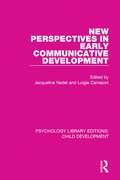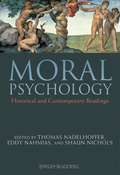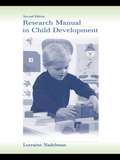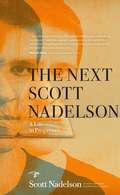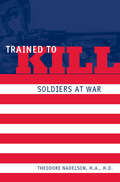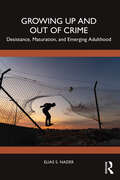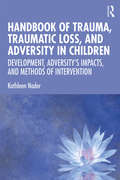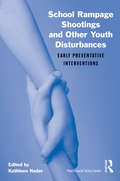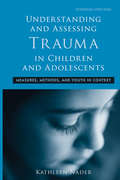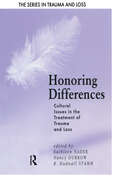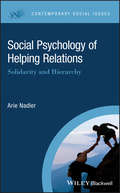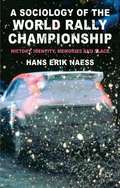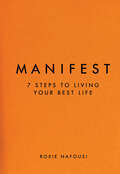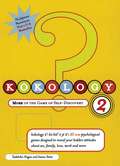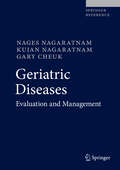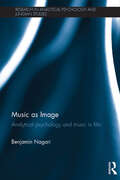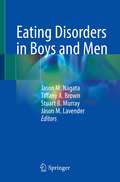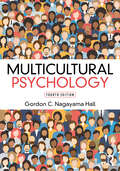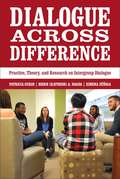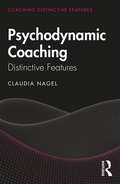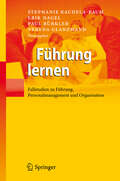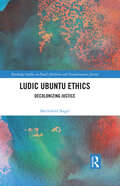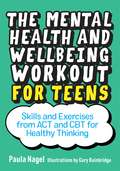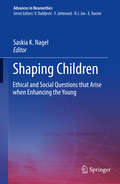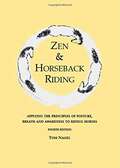- Table View
- List View
New Perspectives in Early Communicative Development (Psychology Library Editions: Child Development #8)
by Jacqueline Nadel Luigia CamaionSince the 1970s researchers in the communicative development of infants and small children had rejected traditional models and began to explore the complex, dynamic properties of communicative exchanges. This title, originally published in 1993, proposed a new and advanced frame of reference to account for the growing body of empirical work on the emergence of communication processes at the time. Communication development in the early years of life undergoes universal processes of change and variations linked to the characteristics and qualities of different social contexts. The first section of the book presents key issues in communication research which were either revisited (intentional communication, imitation, symbolic play) or newly introduced (co-regulation, the role of emotions, shared meaning) in recent years. The second section provides an account of communication as a context-bound process partly inspired by theoretical accounts such as those of Vygotsky and Wallon. Included here are new studies showing differences in communication between infants compared with those between infants and adults, which also have important methodological implications. With perspectives from developmental psychology, psycholinguistics and educational psychology, the international contributors give a multi-disciplinary account of the expansion, variety and richness of current research on early communication. This title will be of particular interest to those involved in child development and communication research, as well as for social, educational and clinical psychologists.
Moral Psychology: Historical and Contemporary Readings
by Thomas Nadelhoffer Eddy Nahmias Shaun NicholsMoral Psychology: Historical and Contemporary Readings is the first book to bring together the most significant contemporary and historical works on the topic from both philosophy and psychology. Provides a comprehensive introduction to moral psychology, which is the study of psychological mechanisms and processes underlying ethics and morality. Unique in bringing together contemporary texts by philosophers, psychologists and other cognitive scientists with foundational works from both philosophy and psychology. Approaches moral psychology from an empirically informed perspective. Explores a wide range of topics from passion and altruism to virtue and responsibility. Editorial introductions to each section explain the background of and connections between the selections.
Research Manual in Child Development
by Lorraine NadelmanThis unique hands-on lab manual in child development provides great ideas and resources for teaching research courses involving child subjects. It includes projects in psychomotor/perceptual, cognitive, and social development. Projects are preceded by background essays on the history of that topic, related research, theoretical issues, and controversies. Each project has hypotheses to test, detailed procedures to follow, all stimuli, individual and group data sheets, empty tables, suggested statistics, discussion questions, and an updated bibliography. Special features of this second edition: *The introductory text portion details research considerations, including an introduction to psychological research, sections on developmental research, children as subjects, and general experimental research procedures. *The popular Infant Observation project has the student visit homes with babies for a semester and provides practice in observational data collection, reliability assessment, and report writing. *The cognitive development section includes two new subfields: Theory of Mind and Language--Children's Interpretation of the Word Big, in addition to classic studies of Piaget's spatial perspective-taking and attention and memory. The final chapter describes a suggested neuropsychological project. *The socialized child section includes a new study on sibling relationships as seen by the older or younger sibling, in addition to the earlier projects on self-esteem, sex identity, and cooperation-competition. The final section describes a suggested cross-cultural interview project.
The Next Scott Nadelson
by Scott NadelsonBeginning in the summer of 2004, Scott Nadelson's life fell apart. His fiancée left him a month before their planned wedding for another woman who made her living performing as a drag king. He moved into a drafty attic. His car's brakes went out. He learned that his cat was dying. Over the next two years, he'd struggle, with equivocal and sometimes humiliating results, to get back on his feet, in the process re-examining his past to understand his present circumstances.The Next Scott Nadelson: A Life in Progress is a literary self-portrait that revolves around the dissolution of a relationship but encompasses the long process of a young man's halting self-discovery. Exploring episodes from the life of its author/narrator marked by failure, suffering, and hope, as well as literary and cultural influence, the book weighs the things that make us want to give up against the things that keep us going. Though many of the pieces are comic and self-deprecating-some self-lacerating-they are above all meditations on the nature of the self and the way it can be constructed through memory, desire, and the imagination. Together they form a larger narrative, a search for fulfillment and identity in a life often governed by fear.With humor and unflinching honesty, Scott Nadelson scrutinizes his life to discover who he is and finds just how elusive such a discovery can be. To read the resulting book is to join him on a personal journey that is thoughtful, surprising, occasionally hilarious, and unapologetically human.
Trained to Kill: Soldiers at War
by Theodore NadelsonIn two decades of clinical work with Vietnam veterans, psychiatrist Theodore Nadelson sought to understand a seeming paradox about his patients: even veterans being treated for post traumatic stress disorder often still felt attracted to the danger and violence of combat and killing. How this could be possible became a central focus of Nadelson's work and thought, as he looked to veterans' stories and within himself for pieces of the human puzzle.This compelling book is the result of that exploration. In it, Nadelson confronts a dark side of human psychology with sensitivity and depth, revealing startling truths about the allure of violence. Among the topics he addresses are the ways in which the concept of war shapes boys' lives from an early age, what happens when killing becomes a job, and how memories of the thrill of combat affect a soldier after the war is over. He probes the aftermath of September 11, including the historic implications of women's experience in the military. A veteran himself, the author weaves together insights from his own clinical and military experience and from the moving narratives of former soldiers with his thoughtful analysis of readings from world literature to answer tough questions: What does our attraction to killing mean for the future of war and civilization? What implications does it have for the way we understand peacetime violence in our society?
Growing Up and Out of Crime: Desistance, Maturation, and Emerging Adulthood
by Elias Samir NaderDevelopmental norms and expectations for young people aged 18–25 have diverged from previous generations, shifting the role of maturation that prompts us to examine if and how this maturation can influence desistance from crime. Utilizing evidence from the narratives of justice-involved emerging adults, this book details key turning points for young people trying to desist from crime. Building on evidence from researchers and theorists as well as from the author’s own narrative interviews, this book provides a brief and approachable review of the extant literature, summarizing work across the fields of developmental psychology, sociology, and criminology to provide the reader with an understanding of the maturation of young people in their late teens and 20s before concluding with considerations for policy and practice building from this evidence. Growing Up and Out of Crime is perfect for students, scholars, and academics who study young people and behavior across the life course and maturation, deviance, and desistance as well as for practitioners working on desistance or working with young people engaged in deviance.
Handbook of Trauma, Traumatic Loss, and Adversity in Children: Development, Adversity’s Impacts, and Methods of Intervention
by Kathleen NaderThe Handbook of Trauma, Traumatic Loss, and Adversity in Children is a developmentally oriented book rich with findings related to child development, the impact of trauma on development and functioning, and interventions directed at treating reactions to trauma. Aspects of attachment and parenting and the use of interrelationships toward therapeutic ends are included in each age-related section of the book, ranging from 0 to 18+. Consolidating research from a range of disciplines including neurobiology, psychopathology, and trauma studies, chapters offer guidance on the potentially cascading effects of trauma, and outline strategies for assisting parents and teachers as well as children. Readers will also find appendices with further resources for download on the book’s website. Grounded in interdisciplinary research, the Handbook of Trauma, Traumatic Loss, and Adversity in Children is an important resource for mental health researchers and professionals working with children, adolescents, and families during the ongoing process of healing from traumatic exposure.
School Rampage Shootings and Other Youth Disturbances: Early Preventative Interventions (Psychosocial Stress Series)
by Kathleen NaderTogether, School Rampage Shootings and Other Youth Disturbances and its accompanying CD provide a complete toolkit for using early preventative interventions with elementary-school age children. In ten thoughtful, clearly written chapters, both new and experienced practitioners will find a wealth of research- and evidence-based techniques that link personal child and childhood environmental conditions to a number of symptoms, disturbances, and disorders in youth or adulthood, including the expression of rampage violence. In the second part of this indispensable collection – the accompanying CD – practitioners will find worksheets and handouts that translate useful techniques into reality and are sure to make any practice come alive.
Understanding and Assessing Trauma in Children and Adolescents: Measures, Methods, and Youth in Context (Psychosocial Stress Series #Vol. 35)
by Kathleen NaderIn this volume, Kathleen Nader has compiled an articulate and comprehensive guide to the complex process of assessment in youth and adolescent trauma. There are many issues that are important to evaluating children and adolescents, and it is increasingly clear that reliance on just one type of assessment does not provide the most accurate results. From history to recent advances, this book covers a wide range of methods and measures for assessing trauma, including case examples to illustrate the integration of these different facets. Altogether, the broad scope and inclusive depth of this work make it an essential addition to the field of trauma assessment.
Honoring Differences: Cultural Issues in the Treatment of Trauma and Loss (Series in Trauma and Loss)
by Kathleen Nader Nancy Dubrow B. Hudnall StammWars, violence, and natural disasters often require mental health interventions with people from a multitude of ethnic groups, religions, and nationalities. Within the United States, those who care for the victims of trauma often assist individuals from a variety of immigrant cultures. Moreover, many aspiring mental health professionals from other countries seek training in the United States, creating an additional need for a broad cultural awareness within educational institutions.Honoring Differences deals with the treatment of trauma and loss while recognizing and understanding the cultural context in which the mental health professional provides assistance. Training in the cultural beliefs that may interact with traumatic reactions is essential, both to assess traumatic response accurately and to prevent harm in the process of assessing and treating trauma. Various cultures within the United States and several international communities are featured in the book.Each culturally-specific chapter aims to help the caregiver honor the valued traditions, main qualities, and held beliefs of the culture described and prepare to enter the community well-informed and well-equipped to intervene or consult effectively. Further more, the book provides information about issues, traditions, and characteristics of the culture, which are essential in moving through the phases of post-trauma or other mental health intervention.Mental health professionals, trauma specialists, missionaries, and organizations that send consultants to other nations, will find Honoring Differences essential reading. It will also be a resource to those who are interested in cultural differences and in honoring the belief systems of other cultures and nations.
Social Psychology of Helping Relations: Solidarity and Hierarchy (Contemporary Social Issues)
by Arie NadlerExamines the major aspects of giving and receiving help in interpersonal and intergroup relations This unique book extends the traditional emphasis on interpersonal help-giving in order to consider a wider spectrum of interpersonal and intergroup helping relations. Help giving is viewed as reflecting people’s care for others, while at the same time dependency on help and giving help imply lower and higher places on the social hierarchy, respectively. It studies the psychology of what goes into helping someone and integrates experimental work conducted in the social psychological laboratory with applied research from volunteer organizations, schools, and work and family environments. In addition to research on the giving of help, the book considers the recipient of help and reviews research and theory on people's readiness to seek and receive help. Unlike much of past research in this context that has been interested in the “generosity question” (i.e., whether or not people help others) the book considers how different kinds of assistance (i.e., autonomy and dependency-oriented help) shape helping interactions. It then goes beyond the analyses of the immediate helping interaction to consider the long-term consequences of giving and receiving help. Finally, the book addresses theory and research on intergroup helping relations. Social Psychology of Helping Relations: Solidarity and Hierarchy begins with a general introduction to the topic. It then offers a series of broad perspectives, covering the philosophical and psychological theory, evolution, and overview of social psychological research. Next, the book looks at the social psychology of helping relations, examining the parties involvedt, and the “why” behind their actions. The positives and negatives of giving and receiving assistance, and the links between status and interpersonal and intergroup helping relations are also covered. It considers how giving, seeking and receiving help maintains or challenges status relations between individuals and groups. The book finishes with a conclusion that wraps up the many lessons learned. Looks at solidarity and inequality in social interactions Examines why people are ready to give and receive help Studies the consequences of giving and receiving help Highlights important implications to different kinds of help beyond the dichotomy between giving/receiving help or not Addresses research and theory on interpersonal and intergroup helping relations The implications of helping relations for personal and social change Social Psychology of Helping Relations: Solidarity and Hierarchy is an ideal book for advanced students, researchers and individuals interested in social psychology, counselling, social work, Sociology, and Political Science.
A Sociology of the World Rally Championship
by Hans Erik NaessDrawing upon interviews with key people in the World Rally Championship as well as trans-local ethnographic research, this book explores questions of commerciality and sporting identity, tackling the sport's controversial handling of the shift into 'the commercial age'. It is essential reading on combining sporting heritage and commercial progress.
Manifest: 7 Steps to Living Your Best Life
by Roxie NafousiTHE INSTANT INTERNATIONAL BESTSELLER Change your life with the first truly practical guide to manifesting, the hugely popular self-development practice that will transform your life for good . . . Written by self-development coach and 'Queen of Manifesting' Roxie Nafousi, this book is the essential guide to anyone and everyone wanting to feel more empowered in their lives. In just seven simple steps you can understand the true art of manifestation and create the life you have always dreamed of. Whether you want to attract your soulmate, land the perfect job, buy the home you have always wanted, or simply find more inner-peace and confidence, Manifest will teach you exactly how to get there . . . 1. Be clear in your vision2. Remove fear and doubt3. Align your behavior4. Overcome tests from the universe5. Embrace gratitude without caveats6. Turn envy into inspiration7. Trust in the universe A meeting of science and wisdom, manifesting is a philosophy and a self-development practice to help you reach for your goals, cultivate self-love and live your best life. Unlock the magic for yourself and begin your journey to turning your dreams into reality.
Kokology 2
by Tadahiko Nagao Isamu SaitoKokology 2 offers all-new insights into the surprising real you. Kokology, the popular Japanese pop-psych quiz game, is now an American bestseller, and Kokology 2 offers more than 50 all-new quizzes, perfect for beginners and experienced kokologists alike. Kokology, the study of kokoro ("mind" or "spirit" in Japanese), asks you to answer questions about seemingly innocent topics -- such as which is the cleanest room in an imaginary house? -- and then reveals what your answers say about you. Play it alone as a quest of self-discovery, or play with friends, if you dare!
Geriatric Diseases: Evaluation And Management
by Nages Nagaratnam Kujan Nagaratnam Gary CheukThis volume provides a comprehensive overview of the unique clinical entities of diseases in older patients. The book arranges the organ systems in 21 sections, which include over 100 collective chapters on various age-related diseases in these organ systems. The text is specifically designed for ease-of-use and include learning tools that include multiple choice, short answer, and extended matching questions, case vignettes, self-assessments, and rich tables and illustrations. Each section includes a review of the anatomy, physiology and pathology that are specific to aging patients. The text covers the complex factors that present diagnosis challenges, including the interaction of the disease process with co-existing morbidities, aged- related physiological changes and pre-existing functional challenges and psychosocial circumstances. The text also works with the previously published text Diseases in the Elderly: Age-Related Changes and Pathophysiology, which is tailored to complement this resource.Written by experts in the field, Geriatric Diseases: Clinical Expression, Management and Impact is the ultimate guide on clinical expression and management of diseases in the elderly for medical students, residents, fellows, geriatricians, gerontologists, primary care physicians, internal medicine specialists, emergency room physicians, specialist nurses, and all other physicians and medical professionals treating older patients.
Music as Image: Analytical psychology and music in film (Research in Analytical Psychology and Jungian Studies)
by Benjamin NagariThrough a theoretical and practical exploration of Jungian and post-Jungian concepts surrounding image, this book moves beyond the visual scope of imagery to consider the presence and expression of music and sound, as well as how the psyche encounters expanded images – archetypal, personal or cultural – on both conscious and unconscious levels. By closely examining music in film, Nagari considers music’s complementary, enhancing, meaningful, and sometimes disruptive, contribution to expressive images. Chapters present a Jungian approach to music in film, highlighting how ‘music-image’ functions both independently and in conjunction with the visual image, and suggesting further directions in areas of research including music therapy and autism. Divided into three cumulative parts, Part I explores the Jungian psychological account of the music-image; Part II combines theory with practice in analysing how the auditory image works with the visual to create the ‘film as a whole’ experience; and Part III implements a specific understanding of three individual film cases of different genres, eras and styles as psychologically scrutinised ‘case histories’. Music as Image will be of interest to academics and students in the fields of applied psychoanalysis and Jungian psychology, music, film and cultural studies. With implications for music therapy and other art-based therapies, it will also be relevant for practising psychotherapists.
Eating Disorders in Boys and Men
by Jason M. Nagata Tiffany A. Brown Stuart B. Murray Jason M. LavenderBoys and men with eating disorders remain a population that is under-recognized and underserved within both research and clinical contexts. It has been well documented that boys and men with eating disorders often exhibit distinct clinical presentations with regard to core cognitive (e.g., body image) and behavioral (e.g., pathological exercise) symptoms. Such differences, along with the greater likelihood of muscularity-oriented disordered eating among boys and men, emphasize the importance of understanding and recognizing unique factors of clinical relevance within this population.This book reviews the most up-to-date research findings on eating disorders among boys and men, with an emphasis on clinically salient information across multiple domains. Five sections are included, with the first focused on a historical overview and the unique nature and prevalence of specific forms of eating disorder symptoms and body image concerns in boys and men. The second section details population-specific considerations for the diagnosis and assessment of eating disorders, body image concerns, and muscle dysmorphia in boys and men. The third section identifies unique concerns regarding medical complications and care in this population, including medical complications of appearance and performance-enhancing substances. The fourth section reviews current findings and considerations for eating disorder prevention and intervention for boys and men. The fifth section of the book focuses on specific populations (e.g., sexual minorities, gender minorities) and addresses sociocultural factors of particular relevance for eating disorders in boys and men (e.g., racial and ethnic considerations, cross-cultural considerations). The book then concludes with a concise overview of key takeaways and a focused summary of current evidence gaps and unanswered questions, as well as directions for future research. Written by experts in the field, Eating Disorders in Boys and Men is a comprehensive guide to an under-reported topic. It is an excellent resource for primary care physicians, adolescent medicine physicians, pediatricians, psychologists, clinical social workers, and any other professional conducting research with or providing clinical care for boys and men with eating disorders. It is also an excellent resource for students, residents, fellows, and trainees across various disciplines.
Multicultural Psychology: Third Edition
by Gordon C. Nagayama HallThe new edition of this bestselling textbook, Multicultural Psychology, helps students gain an understanding of how race, ethnicity, and culture shape their beliefs and behavior as well as those of people around them. Giving a voice to people underrepresented in psychology and society, this book introduces multicultural research in biological, developmental, social, and clinical psychology. The book reviews histories, gender roles, and LGBTQ intersectionality of African Americans, Latinx Americans, Asian Americans/Native Hawaiians/Pacific Islanders, Native Americans, Americans of Middle Eastern and North African heritage, and Americans with Multiple Racial/Ethnic Heritages to provide in-depth coverage of the largest groups of color in the United States. It provides the perfect balance of careful presentation of psychological concepts, research, and theories, and a sensitive, expertly rendered discussion of their applications to people of color. This book is ideal for a course on Multicultural Psychology and a must read for all psychology students as well as for everyone interested in multiculturalism. It is accompanied by a full, updated set of resources for students and lecturers. Content new to this edition includes: A chapter on Emerging Groups covering Americans of Middle Eastern and North African heritage, and Americans with Multiple Racial/Ethnic Heritages Up-to-date research on a rapidly growing multicultural literature Review of research on cultural responses to COVID-19 Coverage of White privilege and Whiteness Expanded coverage of qualitative research methods Recent neuroscience research on personally relevant interventions Expanded coverage of LGBTQ intersectionality A glossary Updated instructor and student resources, including PowerPoint lecture slides, video resources, and classroom exercises and activities
Dialogue Across Difference: Practice, Theory, and Research on Intergroup Dialogue
by Biren Ratnesh Nagda Patricia Gurin Ximena ZunigaDue to continuing immigration and increasing racial and ethnic inclusiveness, higher education institutions in the United States are likely to grow ever more diverse in the 21st century. This shift holds both promise and peril: Increased inter-ethnic contact could lead to a more fruitful learning environment that encourages collaboration. On the other hand, social identity and on-campus diversity remain hotly contested issues that often raise intergroup tensions and inhibit discussion. How can we help diverse students learn from each other and gain the competencies they will need in an increasingly multicultural America? Dialogue Across Difference synthesizes three years’ worth of research from an innovative field experiment focused on improving intergroup understanding, relationships and collaboration. The result is a fascinating study of the potential of intergroup dialogue to improve relations across race and gender. First developed in the late 1980s, intergroup dialogues bring together an equal number of students from two different groups – such as people of color and white people, or women and men – to share their perspectives and learn from each other. To test the possible impact of such courses and to develop a standard of best practice, the authors of Dialogue Across Difference incorporated various theories of social psychology, higher education, communication studies and social work to design and implement a uniform curriculum in nine universities across the country. Unlike most studies on intergroup dialogue, this project employed random assignment to enroll more than 1,450 students in experimental and control groups, including in 26 dialogue courses and control groups on race and gender each. Students admitted to the dialogue courses learned about racial and gender inequalities through readings, role-play activities and personal reflections. The authors tracked students’ progress using a mixed-method approach, including longitudinal surveys, content analyses of student papers, interviews of students, and videotapes of sessions. The results are heartening: Over the course of a term, students who participated in intergroup dialogues developed more insight into how members of other groups perceive the world. They also became more thoughtful about the structural underpinnings of inequality, increased their motivation to bridge differences and intergroup empathy, and placed a greater value on diversity and collaborative action. The authors also note that the effects of such courses were evident on nearly all measures. While students did report an initial increase in negative emotions – a possible indication of the difficulty of openly addressing race and gender – that effect was no longer present a year after the course. Overall, the results are remarkably consistent and point to an optimistic conclusion: intergroup dialogue is more than mere talk. It fosters productive communication about and across differences in the service of greater collaboration for equity and justice. Ambitious and timely, Dialogue Across Difference presents a persuasive practical, theoretical and empirical account of the benefits of intergroup dialogue. The data and research presented in this volume offer a useful model for improving relations among different groups not just in the college setting but in the United States as well.
Psychodynamic Coaching: Distinctive Features (Coaching Distinctive Features)
by Claudia NagelIn Psychodynamic Coaching: Distinctive Features, Claudia Nagel presents a comprehensive overview of the unique features of psychodynamic coaching. As leaders and managers acknowledge the need to understand themselves and their context by looking underneath the surface to improve their decision-making, psychodynamic approaches offer unique insight. Psychodynamic Coaching: Distinctive Features covers not only the major theory but also the practice of coaching, giving guidance from beginning to end of the client relationship. Constructive, holistic and accessible, it demonstrates the impact and dynamics of the unconscious whilst illustrating the power of understanding human behaviour in the complexity of the modern world. With a focus on emotions and relationships in supporting modern leaders adapting to organsational challenges, this book will be an invaluable tool for coaches of all backgrounds, academics and students of coaching and organisational behaviour, and also clinicians. It will also be a key resource for senior leaders for their own personal growth.
Führung lernen
by Erik Nagel Verena Glanzmann Paul Bürkler Stephanie Kaudela-BaumFür diese Fallstudiensammlung wurden 50 praxisrelevante, aktuelle und "typische" Fälle aus den Führungsetagen zu verschiedenen Themenfeldern der Personalführung aufbereitet. Im Vordergrund steht die Beschreibung alltäglicher Führungs- und Managementsituationen, d. h. konkreter Verhaltensweisen und Handlungsabfolgen von Führenden und Geführten in Non-Profit- sowie For-Profit-Organisationen. Kurzzusammenfassungen, Falleinstufungen, "Teaching Notes", Literaturempfehlungen und ein Stichwortverzeichnis verschaffen Dozierenden einen raschen Überblick.
Ludic Ubuntu Ethics: Decolonizing Justice (Routledge Studies in Penal Abolition and Transformative Justice)
by Mechthild NagelLudic Ubuntu Ethics develops a positive peace vision, taking a bold look at African and Indigenous justice practices and proposes new relational justice models. ‘Ubuntu’ signifies shared humanity, presenting us a sociocentric perspective of life that is immensely helpful in rethinking the relation of offender and victim. In this book, Nagel introduces a new theoretical liberation model—ludic Ubuntu ethics—to showcase five different justice conceptions through a psychosocial lens, allowing for a contrasting analysis of negative Ubuntu (eg., through shaming and separation) towards positive Ubuntu (eg., mediation, healing circles, and practices that no longer rely on punishment). Providing a novel perspective on penal abolitionism, the volume draws on precolonial (pre-carceral) Indigenous justice perspectives and Black feminism, using discourse analysis and a constructivist approach to justice theory. Nagel also introduces readers to a post secular turn by taking seriously the spiritual dimensions of healing from harm and highlighting the community’s response. Spanning disciplinary boundaries and aimed at readers seeking to understand how to move beyond reintegrative shaming and restorative justice theories, the volume will engage scholars of criminology, philosophy and law, and more specifically penal abolitionism, social ethics, peace studies, African studies, critical legal studies, and human rights. It will also be of great interest to practitioners and activists in restorative justice, mediation, social work, and performance studies.
The Mental Health and Wellbeing Workout for Teens: Skills and Exercises from ACT and CBT for Healthy Thinking
by Paula NagelThis easy-to-understand, engaging guide arms teens with healthy thinking habits and coping strategies for staying on top of their mental health. Using tried and tested therapeutic techniques, readers are given the tools to build their own personalised mental health 'workout' to boost their emotional resilience and wellbeing.Informed by the experiences of teens themselves, this friendly guide gives practical tips and strategies on how to overcome everyday stresses and ditch negative thinking 'frenemies' before they develop into more serious issues. Teens will be better equipped to recognise negative thoughts and emotions, monitor their mood and behaviour, and flex their positive thinking muscles in order to combat the mental health blips we all face sometimes.
Shaping Children: Ethical and Social Questions that Arise when Enhancing the Young (Advances in Neuroethics)
by Saskia K. NagelThe volume offers a unique collection of articles on pediatric neuroenhancement from an international and multidisciplinary perspective. In recent years, the topic of “neuroenhancement” has become increasingly relevant in academia and practice, as well as among the public. While autonomous adults are free to choose neuroenhancement, in children it presents its own ethical, social, legal, and developmental issues. A plethora of potential (neurotechnological) enhancement agents are on the market. While the manifold issues surrounding the topic have been extensively discussed, there is little work on the specific questions that arise in children and adolescents. This book addresses this gap in the literature: Next to conceptual and normative work on autonomy and self-control, the collection explores the implications for parenting and schooling, and provides input for a discussion of public attitudes. It is a valuable resource for the different academic communities confronted with questions of how to evaluate and approach enhancement in children and is of interest to neuroethicists, scholars in applied ethics and neurology, psychiatrists and psychologists as well as scientists developing enhancement interventions for children.
Zen And Horseback Riding: Applying The Principles Of Posture, Breath And Awareness To Riding Horses
by Tom Nagel Sally SwiftZen & Horseback Riding explains the location, importance and use of the psoas muscles. The psoas are the deep core muscles that link the upper and lower girdles of the body. They are the basis of all efficient body movement and can be used by everyone in any athletic activity. This book explains how to use your body to achieve tone, find self-carriage and to move correctly both on and off the horse. Zen & Horseback Riding is about using horseback riding as a means of self-development and training. It is about improving both your riding and your life. "synopsis" may belong to another edition of this title.
